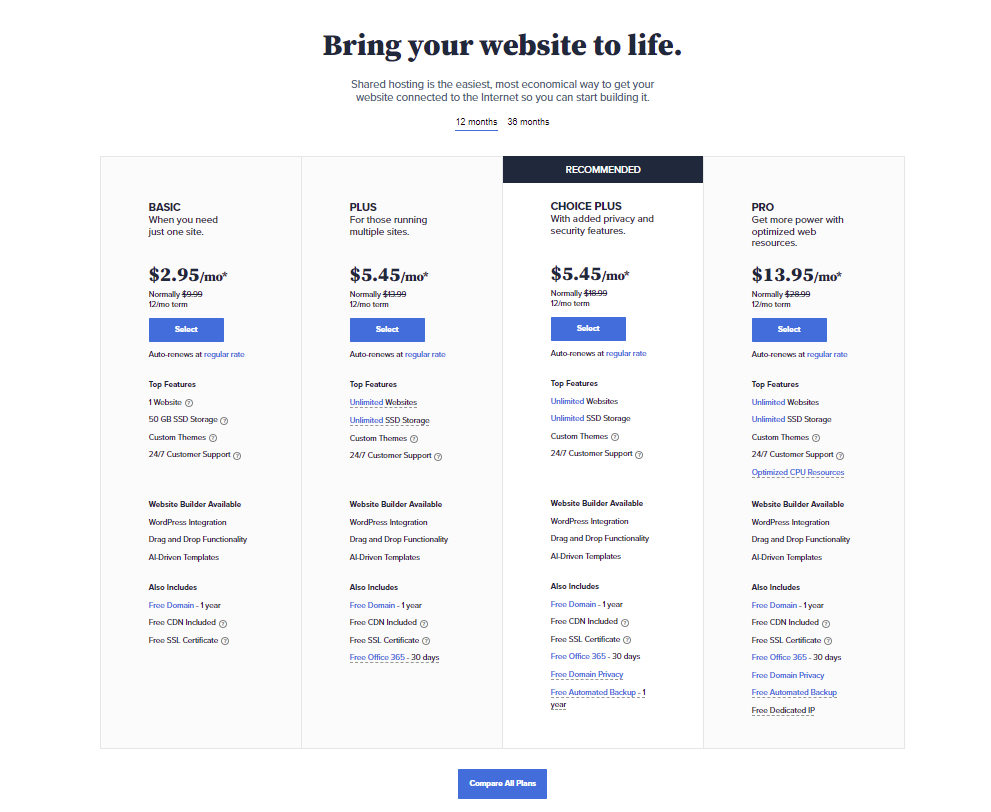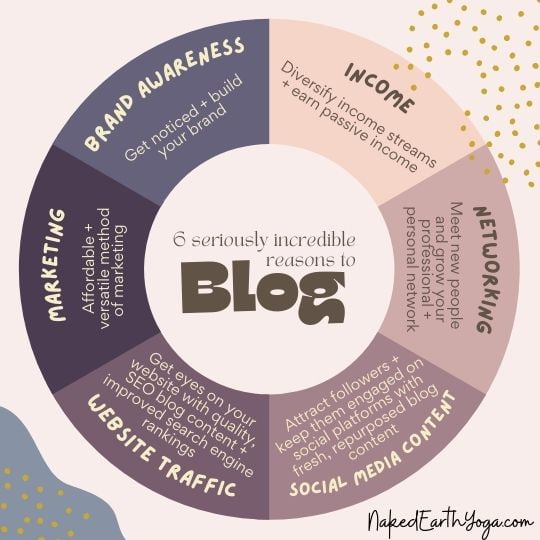Now is the time to start a yoga blog. Whether you’ve been putting it off, haven’t known where to begin, or finally have the time to create content, consider this your moment.
Here’s your sign.

Or the inspiration you’ve been hoping to stumble upon. Or consider this an opportunity to reinvent yourself as a yoga blogger.
If you want to become a yoga blogger, expand the reach of your yoga teaching business, or establish yourself as an expert in a particular yoga niche, this guide will step you through what you need to do to start a yoga blog. Step-by-step.
This guide will explain everything you need to know to get started blogging.
So, indulge yourself in this idea: Your very own yoga blog.
Imagine that. Sounds good, doesn’t it?
Let’s get started.
Affiliate Links Disclosure: Naked Earth Yoga is reader-supported. When you buy through links on our site, we may earn an affiliate commission at no added cost to you. Thank you for reading. You can read the full privacy policy here.
Table of Contents
ToggleWhy You Need a Yoga Blog
There are some seriously incredible and important reasons why you need a yoga blog on your business website. If you’re a yoga teacher or yoga entrepreneur, a successful yoga blog could be a game changer in terms of attracting yoga students and clients.
Having a powerful, dynamic web presence is important for small business growth. Having a blog can help you stand apart from the crowd. To illustrate, in 2018, “46% of small businesses didn’t have a web presence.” What this means for you, the yoga teacher, is that there is mega opportunity for you to promote your yoga business, create quality content, build a strong online presence, and stand out among your competitors.
If you like writing and engaging with people, blogging and content creation can be so much fun. Don’t worry, even if you don’t enjoy writing yet, when traffic starts rolling into your blog and you see that people actually enjoy reading what you write, you’ll catch the blogging bug!
Low-Cost or Free Business Marketing
A blog is an affordable marketing tool that can deliver results, especially when part of a comprehensive yoga biz marketing strategy. It can help you get your website visitors, attract yoga students, get you ranked on Google, and help you establish yourself as a yoga expert in a particular niche.
Plus, if you want to drive up annual yoga revenue, hit mega sales goals, and increase exposure, well, a yoga blog is practically a no-brainer.
LEARN MORE: Dive deep into 6+ reasons why you need a blog in Reasons You Need a Yoga Blog.
The Difference Between a Website and a Blog
If you’re currently scratching your head right now and thinking, “Huh? I don’t have a yoga website or a yoga blog right now. I’m screwed,” don’t worry.
Let me briefly explain the difference between a website and a blog, before going any further.
A website is a site where you have your online business presence. For example, you can find my business website at NakedEarthYoga.com. A website tends to be static. In other words, it doesn’t get changed often. For example, a website might contain several different pages, such as one with your yoga studio information, another with an about page or services page, a separate page with yoga studio rules, etc.
A blog itself can be a stand alone website or it can be part of your website. Typically, “a blog” is dynamic, with period updates or additions of new “blog posts.” For example, my Business of Yoga blog, located on my Naked Earth Yoga website, is updated weekly with new yoga inspiration and digital marketing tips to help you grow your yoga business. For the most part, the other areas of my website don’t change all that often. My blog, however, does.
The Perks and Pros of Having a Yoga Blog
Like I mentioned earlier, there are some serious benefits to writing a yoga blog. You can read about many of those benefits in detail in 6+ Reasons to Have a Yoga Blog for Your Yoga Business.
In fact, I’m so convinced that a blog is critical to yoga teacher business success–and to any small business growth, really–that my blog is dedicated to keeping you updated about practical tips and the best tools for blogging, online business marketing, and offering real value to your yoga audience.
A Step-By-Step Guide to Creating a Yoga Blog
So, where do you begin if you want to create a yoga blog?
This DIY blog guide can help you take the overwhelm out of building a blog.
As a word of caution, while you’ll soon discover that web hosting and setting up a blog is now easier than ever, there is still a learning curve that comes with blogging. After all, if blogging was so easy to do, everyone would blog or have their own blog. So, please, don’t get discouraged if you run into any stick technology or content building issues. You can do this! Plus, I’m here to help get you unstuck.
And, as someone who absolutely LOVES blogging, I can tell you this… if you hang in there, consistently work on building and growing your blog, publish high quality content, and optimize your blog posts for search engines (think SEO), you’ll likely LOVE the results.
To me, blogging is a like creating art. It’s satisfying to create. To see your work spark conversations. And to know that you’ve inspired or engaged your audience.
Okay, are you ready to get started?
Steps to Launch YOUR Yoga Blog
Let’s explore the steps you need to take to launch your yoga blog.
1. Get into the Business Mindset – Business + Blog Considerations
There are many practical considerations to think about when launching your yoga blog. For example, you need to choose a domain name (think your “www”) that isn’t taken or claimed by someone else or another company. If you’re not sure if a particular domain name interferes with someone else’s Intellectual Property rights, consult a legal professional.
Take some time to brainstorm ideas. Whatever name you decide to go with, you have to first do your research and pick a domain name that you like and seems like it will work for your business goals.
As you can see, my domain is NakedEarthYoga.com.
1. Choosing a Domain Name
A few additional ideas and points to consider:
- Have fun with this! Don’t get so stressed out trying to pick the perfect name or try to anticipate every single aspect of your future yoga business and the consequences of your name choice. Been there, done that. Trying to nail perfection, just slows you down from starting in the first place. And who knows, if you over analyze, you might never get started as a yoga blogger.
- Pick the best name you can now, though keep in mind, it could be with you for awhile, so you can get started building your blog!
- Branding: Do you want your business and/or domain name to contain your personal name or a business name. Are you the brand? For example, JulesTheYogaTeacher dot com. Do you want your domain name to reflect your yoga niche or passion? For example, YogaforMountainRunners dot com.
- Pick a name that’s easy to say, so when you tell people about your site, they know where to go.
- Aim for a “.com” domain, if possible.
- Avoid words that are commonly misspelled. Like seriously, think about this. For example, if you were to name your site… MyAwesomeQuarantineYoga dot com, (I looked, it doesn’t appear to exist), you should probably be aware that Quarantine is a frequently spelled wrong. You want students and clients to find you!
2. Website Parking + Financial Investment
You also have to figure out where to “park” or host your blog (more on this below). As well, you have to think about your budget. And your business goals.
You’ll also want to think about the purpose of your blog. Ask yourself, why do I want to start a blog in the first place? There’s no sugarcoating it. Building and maintaining a blog takes time. Also, keep in mind that getting noticed, gaining back-links, and achieving a top Google ranking as a go-to site for yoga information takes time.
3. Timing
Deciding when to launch a yoga blog is another important consideration. Timing matters. While you may feel your time is better spent writing yoga class sequences and hanging yoga class posters at the local library, don’t understimate having a blog for yoga.
It’s Never too Early to Start a Yoga Blog
If you want to grow a wildly successful yoga business, establishing a business blog is soooo worth it.
A yoga blog is also worth creating if you are a yoga student interested in becoming a yoga influencer. Or, if you are toying with the idea of taking a yoga teacher training (YTT). Starting a blog now has its advantages.
Namely, it can take months to get ranked by Google. Plus, older blogs with refreshed, updated content sometimes have more inherent search engine “trust.”
4. Your Yoga Blog Niche
Another consideration is to think about: what do you want your blog to be about? What will you write about? How will your blog content add value to yoga students, teachers, or prospective clients?
You’ll want to think first and foremost content creation + marketing strategy. If you have a yoga business niche, figuring out what to blog about might be easy. But if you don’t have a niche yet, it’s the perfect time to think about carving out one.
If you need help finding your yoga or blogging niche, scoop up a copy of my free 50+ Yoga Niche Guide.
Typically, blogs that are narrow in scope or limited to a particular niche perform better than those that are all over the place in terms of content. When a blog is specific, it might get ranked higher by search engines, and also yoga students and clients can find it more easily.
For practical purposes, and for those of you focused on getting your blog up and running fast, the following steps are going to focus on the technical steps for launching your blog.
2. Understand Why You Need a Host – Web hosting Explained
Before we dive into the conversation of how to set up your blog, where to build it, or why it’s a probably a smart idea to make a financial investment in building a blog if you are a business owner or serious about blogging, let me explain a bit about webhosting.
A web hosting service hosts a website for clients.
Websites don’t just run themselves. When you click on a blog, like mine, the content you see displayed is actually stored in files and a database on one or more networked computer servers.
Imagine it like this: your yoga blog, and the files and database needed to display your blog (“www.something…”), is parked on a little corner of Internet real estate. A web host is where your files are parked or stored.
While technically you could run a blog from your own laptop (if you have tech guru skills), picking a web hosting provider gives you a pre-configured environment and an interface to more easily set up and run your blog.
So, this brings you to the BIG question: do you pay for web hosting or do you look for free hosting?
Paid vs. Free Web Hosting
Okay, so you’ve probably heard people talk about how they have a free blog.
Maybe they’ve bragged that they don’t pay anything for blog hosting. You’ve probably also seen advertisements telling you where you can launch a blog for free.
For example, some of these sites offer you the ability to launch a free blog:
- WordPress.org
- Blogger
- Tumblr
- Medium
- Weebly
- Wix
But what’s the catch, right?
The problem with free blogging platforms is that if you are serious about blogging, as in being totally professional about it, or hope to become an influencer or powerhouse blogger, you most likely don’t want a free platform.
If you choose one, you’ll likely feel limited or hampered in your ability grow or customize your blog.
That’s right. You don’t want to go with a free platform.
Sure, free blogging platforms can be useful for tinkering around and getting the lay of the blogosphere land. Some bloggers even once started out using free blog hosting. Hey, ages ago, I once had a blogspot blog. 😉
There’s no doubt, you definitely WILL save money with a free blog, at least initially.
But if your blog grows or you decide to take it up a notch because of the limitations of the free platform, you might have to spend a good chunk of money to upgrade or move your blog to new webhosting.
Professionals, serious bloggers, and influencers generally stay clear from building their own blogs on free blogging platforms. If you want to use your blog to help grow your yoga business, get more traffic to your website, or get noticed, you really should consider setting things up “right” from the get-go. It can save you tons of time and money in the long run.
Why Choose To Pay for Webhosting
Why should you pay for webhosting? Well, it’s simple. When it comes to hosting your blog, you generally get what you pay for.
Free web hosting means you’re going to face limitations and have far less control over your blog than you probably will need if you want to grow it or turn it into a professional part of your yoga business marketing strategy.
Some reasons why you may want to steer clear from free webhosting for your yoga blog:
- You get what you pay for
- Less control + flexibility
- You aren’t fully in control of your content (if the company decides to close shop, go down for maintenance for hours or days, or delete your account, you could lose everything… EEK…think digital sharecropping, where “the landlord has control of your data”!)
- Migrating to a new webhost in the future could be tricky, difficult, or costly
- You might be able to monetize your free blog or you might not earn much
- Your search rankings could be impacted
- You might have a generic domain name and not get to use your personal “www” (domain name) choice
3. Decide Where to Host Your Yoga Blog
There are many webhosting companies that have solid reputations for hosting websites and supporting bloggers. Now, more than ever, it’s a lot harder to make a total mistake in choosing a webhost.
Of course, ideally, you want to park your website with a reputable and well reviewed hosting service.
Some popular paid webhosts include:
- Dreamhost
- Bluehost (a popular pick for brand new bloggers with little technical experience)
- SiteGround
- Ionos
- Digital Ocean (recommended for advanced and technical developers)
I have experience using several webhosts over the years. Bluehost is consistently recommended as a beginner-friendly host by bloggers.
Bluehost consistently stands out as a solid pick for blogging novices. It is well reviewed and was picked as as 2021 PC Magazine Editors’ Choice for Web Hosting. You can “bring your website to life” with BlueHost economically, starting at $2.95/mo.

Pros of Bluehost: Bluehost initial pricing is popular and attractive among new bloggers, starting out at $2.95/mo. for hosting. It is known for solid up-time, so that means you don’t have to worry about your students, clients, or visitors accessing your blog. With Bluehost, you can also set up your email so it includes your domain name, rather than needing to use “gmail” in your email.
Cons: Some bloggers complain that the one thing they don’t like about Bluehost is that pricing goes up after the first year. Sure, no one wants prices to go up, but some webhosting services do this with rates. It just is. However, some bloggers have found workarounds, transfer to another webhost, or pay the new fees after the first year. If you go with Bluehost, you might also discover some upselling, but in general you will probably get the features you pay for.
Sign Up for Bluehost
Once you’ve decided to go with Bluehost, you’ll start the web hosting registration process. The starting point will look something like this:

Chose the option to host your site. During the Bluehost sign-up steps, you’ll choose your hosting plan (you’ll probably want to go for basic to start), and you’ll have an opportunity to enter your desired domain name and/or initiate a process for transferring a domain, if you already have one.
You’ll see add-on offers, like domain privacy protection. You’ll pay a bit extra, but if you’re sensitive or concerned about your privacy, you will want to choose this add-on.
What is domain privacy protection? In brief, it is an added layer of protection that keeps your personal information private and hidden from public view, like your address and phone number, and from showing up in a Whois database when you register a domain name.
Site BackUp: Another up-sell option that’s totally worth adding onto your plan. Site back-up is something that could totally save you, should anything happen with your site or a new installation or upgrade goes awry. So you know, you can also install WordPress site back-up plugins, like UpdraftPlus, but some think paying for this service directly to the web host adds peace of mind.
Commitment Discounts: If at the time of registration, you encounter a deep discount for longer term web hosting beyond a year and your offer price stays locked in, you may want to seriously consider the long-term savings. If you are serious about becoming a yoga teacher or growing a successful, sustainable yoga business, thinking about blog hosting a year down the road might be inconvenient–or annoying. Plus, if you can save money now with your web hosting, why not?
4. Choose Your Blogging Platform – WordPress
Next, once you signed up with your hosting provider, you’ll choose your digital platform or content management system (CMS) for managing your blog.
If you opt for Bluehost, you can take advantage of 1-Click WordPress installation.
By far, WordPress is the top choice for bloggers. Note, the WordPress installation on your paid host is a different experience than if you were to use the free “hosted” version of WordPress at WordPress.com.
5. Start Building Your Blog
Once you have WordPress installed, you can choose from 100s of blog templates or “themes” to create your dream blog layout.
WordPress Themes
Most, if not all, themes you’re likely to stumble upon now are responsive for use on desktop, iPhone, Android devices, or iPad, meaning they will automatically re-size and adjust so they look good, regardless of the device used.
So you know, there are tons of free WordPress themes out there, but you can also choose to buy a theme. Free themes sometimes have limited features, or require a theme developer credit in your blog footer. Paid themes are generally more flexible.
Also, keep in mind, you’re never married to a theme. You can always change themes, though sometimes it can be a lot of work to change things around. So, I highly recommend picking a theme to start with that looks visually appealing to you.
WordPress Plugins
You can also choose WordPress “plugins” that allow your blog to have cool added features or to help make things flow easier on your blog. For example, if you need a privacy or GDPR banner, you can find a plugin that can help you display one.
To reiterate what I mentioned earlier, it takes time to get a solid grasp on blogging and WordPress, so be kind on yourself. Keep at it and you’ll get to where you want to be.
If you get stuck, look to customer support, YouTube tutorials, Reddit forums, or troubleshoot your problem with a Google search. If you get totally stuck, DM me and I can get you in touch with someone who get you sorted out.
Useful Free WordPress Plugins that you may want to install:
- Yoast SEO or All in One SEO
- Elementor
- MailerLite or other embedded email forms (building an email marketing list is key for biz growth)
Pages You’ll Want to Include on Your Site
After you finish with the technical set-up and have a WordPress theme installed, it’s time to think about building out site content. You’ll want to create pages and a menu for your site where your audience can access them.
You might want or need website pages like:
- About (Me) – tell your readers who you are, what you do, and describe any relevant yoga experience or training
- Class schedule – where can your audience register for classes and where do they take place
- Blog – this is that part of your site that will be dynamic and change with your regular blog postings
- Contact – how can your students get in touch with you
- Legal pages – depending on where you’re based, you will likely need a privacy policy or affiliate marketing disclosures (if you are unsure what you need, reach out to a qualified legal professional in your geographic area)

Pretty + Practical Blog Considerations
To ensure your yoga blog looks great, you may also want to consider:
- Creating a Logo. You can hire someone to make a logo for you on the cheap at Fiverr. You can also design your own for Free using Canva. I LOVE Canva and use it every.single.day. 😉
- Beautiful photos. You’ll want to be sure to include great photos on your site and in your regular blog posts. You can use your own images or find free stock photos at Unsplash.
6. Publish Your First Post
It all gets real when you hit publish on your first blog post. For tips on how to create awesome blog content that will (hopefully) go viral, be sure to pop over and read How to Create Awesome Blog Content.
Some basic considerations for publishing that very first blog post:
- What’s the point of your post? Your blog post should be helpful to your audience. It should solve a problem or provide a solution to something that troubles the students or clients you’re trying to attract.
- You post should have a catchy headline or title.
- You should end your first post with a Call to Action (CTA), which gives your reader something specific to do after they read you’re awesome first post. For example, if you want your readers to convert to Instagram followers after reading your post, use a CTA like: “Follow me NOW on Instagram.”
- Think Search Engine Optimization (SEO). Learn More about SEO in my Why SEO + Google Rank Matters Guide.
7. Continue Investing in Your Blog, Yourself, and Your Business
Once you enter the blogging world, there is so much to learn. Sure, you could hire someone to manage your blog, like a virtual assistant, or pay writers to create content for you. However, there’s also a lot of value in teaching yourself the ropes. Plus, you can save money, too.
I’m not suggesting you do it all forever. After all, I know you’re busy teaching yoga classes, sequencing classes, and growing other parts of your business. However, there is so much to learn from teaching yourself blogging fundamentals.
For example, understanding SEO (search engine optimization) can help you think differently and better about digital marketing. It can help you better understand content creation and where to maximize your attention. Learning about blog affiliate opportunities can help you learn about diversifying revenue streams. And blogging can help you become a better writer and communicator.
These are all great business and personal perks of investing in your blog.
If You LOVE This Start a Yoga Blog Guide, Share the LOVE and Pin It


Comment: Do you have a yoga blog? What webhosting service do you use? Do you use a paid or free model? WordPress? Share your thoughts and personal experiences below. I love to hear from readers!




I would not recommend wordpress for blogging because wordpress website need more plugin and this is decrease website speed.
great post . thankyou you for sharing useful information. we are also provider of yoga teacher training in rishikesh